
Along with quick technical enhancements, security risks are enormous in today’s cyberspace. As per forecasts, worldwide cybercrime rates will cost 2 trillion dollars in 2019. Newer types of security threats will emerge every year. Let’s look at some of the major cyber attack types to watch out for and to protect against this year.
- IoT (Internet of things)
IoT is the technology of interconnecting digital devices. While IoT can make a technological revolution, it is a fact that IoT triggers security risks because its devices are more vulnerable to security attacks due the exposure to a wide network of interconnected devices. Many IoT devices have loopholes through which hackers can implement an attack, without much notice.
The number of workplace IoT devices is said to increase enormously in the future. Coordinating numerous IoT devices can result in a catastrophic attack. In 2016, such a coordinated IoT attack has happened. Access to the majority of the internet (sites from HBO, Paypal, FoxNews, Etsy, etc.) was blocked, leading to a government investigation.
Read more at:
http://www.nodericks.com/challenges-todays-hosting-service/
2.Man in the middle attacks
Like IoT, this can also trigger more security risks. Today, technologies like mobility solutions enable connectivity irrespective of location, allowing an employee to conduct official communications as well as responsibilities, even via an unknown network (like wifi in a restaurant). A hacker can intervene to collect sensitive information being sent from the employee in an unsecured network, negatively affecting business efficiency. Installing VPN in employee computers can be a solution, but risks cans still come via devices like mobiles.
3.Ransomware
Ransomwares are malicious softwares designed to block access to a computer system until an amount of money has been paid. It can give nightmares to any business.
In this, a hacker will be sending an email with a malicious (ransomware) file in it. When users open it, this ransomware file is deployed via encrypting and locking specific, sensitive files on their systems. This will enable blocking access to these files and users getting a message stating that they will get the encryption-key to open those files only after paying a certain amount of money to the hacker (usually via an untraceable bitcoin amount).
Paying the ‘ransom’ and regaining access to the blocked files can give negative publicity, giving an impression that the respective organization is willing to pay for the blocked files. At the same time not paying can end up losing business-critical files causing enormous loss. All these make ransomware attacks critical to every business.
Read more at:
http://www.nodericks.com/managing-increased-security-threats/
4. Social Engineering and phishing
Yes, these attacks still work because of people’s involvement. In social engineering and phishing, hackers pretend to be a legitimate institution or person, tricking people to enter sensitive information.
Phishing attacks have become more sophisticated, where hackers launch such attacks in the wake of a legitimate security breach, mostly tricking those who usually do not fall for similar attacks (because they know that there was a security breach).
Phishing attacks are said to be increasing at an alarming rate of 65%, affecting more than 75% of businesses in all industry verticals. In today’s world of social media and email communication, phishing attack have to be considered as a major threat. 2017 phishing attack which affected almost 1billion Gmail users is a famous example.
Read more at:
http://www.nodericks.com/security-threats/
5.Password Cracking
Password cracking is the process of recovering passwords from data that has been stored in or transmitted by a computer system. The common method via hackers do password cracking is by guessing repeatedly and check those guesses against the available cryptographic hash of the password. Today’s sophisticated cracking programs can generate millions of password to try, enabling cracking of even those passwords with special characters. To avoid this, system administrators need to establish strong password policies for the users to follow.
6.Wordpress specific attacks
Researches show that almost 30% of the internet is powered by WordPress. WordPress attacks are increasing enormously. Though secure in general, third-party plugins can be a point of vulnerability in WordPress. Plugins of 25% of hacked WordPress websites were out-of-date. Another security risk factor for WordPress websites are lack of using SSL certificates; these websites can be vulnerable when accessed via an unsecured network. Here, hackers can even be able to get sensitive data through man in the middle attacks.
As the popularity of WordPress is continuously increasing, It is very much essential for businesses to lock down attacks directed at them.
Since IT automation has become a deciding factor for business success, ensuring cybersecurity is a necessity today. Taking various precautions like giving adequate training to employees on cybersecurity, adequate patch updates, implementing VPN-usage in all work-related digital devices, implementing latest security software, other sophisticated security measures like implementing an effective cyber-attack recovery plan, etc. can ensure robust security against cyber attacks.
